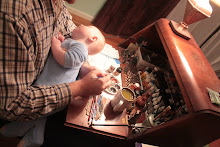Thwarted in my quest to read D&D material from the local library due to lost or stolen material, I settled for the Dungeon Master for Dummies book by Bill Slavicsek and Richard Baker, written for Dungeons and Dragons version 3.5. I had pretty low expectations for this book, and it took me quite a number of lunches to get through, but here are some thoughts:
Much is made of the concept of "DM as social director" where the DM is essentially hosting a party and providing for the entertainment of same. This makes sense if the DM is actually the host, but it seems like there must be groups that meet at clubs/game stores who follow a different arrangement, and someone else is the host and the DM is the "entertainment" for the get together. Still, in game, the concept makes sense, as the DM needs to juggle the personalities of the players to make sure everyone is having "fun" (or otherwise deriving benefit from play).
Feeding into this concept of the DM as entertainer is the idea that the DM is not trying to kill the player characters, but rather, allowing them to play. There is some discussion of when to allow the dice to kill PCs and when to fudge things. An interesting idea on keeping players engaged is to have them recap previous sessions at the start of the next session.
The book effectively summarizes the bloat issues of 3.5 edition by discussing the addition of a class to your game. When adding a class, you are not just adding a single option, but rather dozens due to class/race/feat permutations. An example is given where adding a race is too "powerful", by suggesting a Medusa sorcerer. (actually, I want someone to make a Flailsnail character of that one)
The book includes some random dungeon material, which could be useful to add to other tables you have for that purpose. Also has random encounter tables, and random treasure, as well as a number of "ready to go" encounters and traps with stats and details for 3.5.
The book has a chapter discussing high level play issues, which are different than in earlier editions of D&D, given the power increase of the characters with feats and various powers.
An interesting section of the book discusses how to have a memorable villain, which I think all longer term games could benefit from, even if they are sandboxes.
I do not want to put everyone off this book, but rather suggest that it was not for me. If you were completely new to DMing, and did not spend a year reading blogs on the Internet before doing it, you could read this book and get some useful advice. For me though, it was mostly repetitious of things I have already read or learned on my own, and a bit too specific to the challenges or running a 3.5 game.
In other news, still have not had the time/motivation to paint, so that is nearly four months without touching a brush. Not a great state to be in, particularly when I had three largish projects I wanted to accomplish this year (baneblade, D&D figures, and Dreadfleet).
Thursday, April 26, 2012
Subscribe to:
Post Comments (Atom)


No comments:
Post a Comment